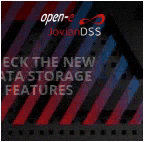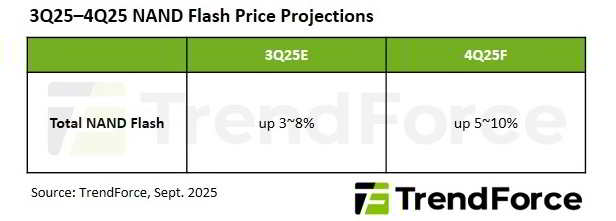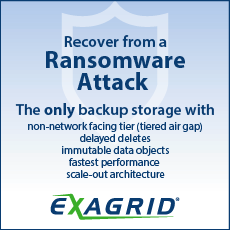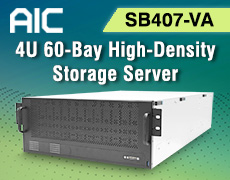NAND Flash Prices to Rise 5–10% in 4Q25, Says TrendForce
Driven by spillover demand for QLC products
This is a Press Release edited by StorageNewsletter.com on October 3, 2025 at 2:02 pmTrendForce Corp.’s latest investigations have revealed that with consumer demand was concentrated in the first half of the year, leading to the traditional 2nd-half peak season underperforming.
The market had expected NAND Flash prices to stabilize in 4Q25. However, HDD shortages and longer lead times have prompted CSPs to quickly redirect storage demand toward QLC enterprise SSDs. This urgent surge in orders has resulted in significant market volatility.
SanDisk was the 1st to announce a 10% price increase, while Micron paused quotations due to pricing and capacity issues. These events shifted supply-side sentiment from cautious to aggressive. Consequently, NAND Flash contract prices across all categories are expected to generally rise, with an average increase of 5–10% in 4Q25.
TrendForce highlights that in the supply side, production reductions and inventory clearance during the first half of the year have greatly enhanced market equilibrium, reducing both suppliers’ inventory and pricing pressures. Aside from a few leading companies planning to expand their new fabs next year, most suppliers are focusing CapEx on migrating to advanced processes in order to improve cost efficiency.
Capacity is allocated to high-margin products to minimize price competition and safeguard profits, creating a price support layer. Regarding the product side, QLC’s cost benefits have increased its adoption in SSDs. As generative AI drives higher demand for extensive data storage, suppliers are more focused on expanding QLC capacity.
On the demand side, the NAND Flash market continues to encounter weak consumer activity, slower OEM purchasing, and high finished-goods inventories in the distribution channels. Nonetheless, server OEMs and CSPs mostly cleared their inventory in the first half of the year. With Nvidia’a upcoming Blackwell chips expected to increase shipments in the 2nd half of 2025 and ongoing HDD shortages, demand for enterprise SSDs is growing rapidly. This situation helps keep the overall NAND Flash demand on a positive path.
Client SSD
In 1H25, production cuts and shipment adjustments by client SSD suppliers have greatly decreased inventories, helping to restore market balance. Meanwhile, the demand for large-capacity QLC SSDs, which are prized for their cost-performance benefits, remains high, further supporting the market.
Enterprise SSD
SSD suppliers are re-evaluating their 2026 order volumes due to increasing demand for enterprise products exceeding 120TB. They are also strategically increasing QLC output shares to adapt to fundamental market changes. Supplier inventories have dropped below healthy levels, and with growing demand for AI and servers in North America, supply shortages in 2026 are becoming increasingly apparent. This situation is likely to drive prices upward in 4Q25.
eMMC/ UFS
Within the NAND Flash supply chain’s profit-driven strategy, SSDs achieve higher margins, whereas eMMC and UFS experience weaker demand. International suppliers face stiff competition from YMTC and many Chinese module makers, increasing bargaining power for local smartphone brands. High inventory levels among module makers could lead to price competition, which might restrict price increases. However, in an effort to recover losses, suppliers are likely to raise eMMC/UFS prices in the 4th quarter of 2025.
NAND Flash Wafer
During process migrations, suppliers faced temporary output gaps caused by line adjustments, which reduced bit output. To compensate for losses from earlier quarters, they are reallocating resources to high-margin product lines, leading to further wafer supply constraints for module houses. As investment in enterprise AI continues to grow, the tight supply conditions are expected to persist, pushing wafer prices higher in 4Q25.
Comments
NAND revenue continues to rise and at the same time a small price increase appears to be a necessity as QLC really leads the demand. This is of course an effect of QLC demands from hyperscalers and globally enterprise in all domains but AI really ranks #1 meaning that SSD is present in all market segments and verticals, no surprise here. Hyperscalers are looking for low cost QLC SSDs as they consume all these storage devices as just components and commodities. But it appears that HDD vendors struggle with production.
On this SSD demand, large capacity flash drives show strong demand for 122TB QLC and we anticipate a new battle on these as Huawei, Kioxia, Micron, Phison, Samsung, Sandisk, SK hynix and Solidigm announced their offering. And we can easily imagine what it will become for 245-256TB when they will be available as they will drive a density standard for exascale rack.














 Subscribe to our free daily newsletter
Subscribe to our free daily newsletter

